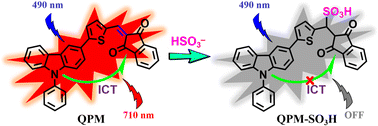Carbazole-based near-infrared-emitting fluorescence probe for the detection of bisulfite in live animals and real food samples†
Abstract
Bisulfite (HSO3−) is a significant food additive that is widely used in pharmaceutical products and various foodstuffs due to its antibacterial, antioxidant and bleaching properties. Additionally, as a derivative of a biological signal molecule (SO2), it also participates in a large number of physiological and pathological processes in organisms. Nevertheless, human health is seriously affected by the excessive intake and abnormal expression of HSO3−. Consequently, there is an urgent need to develop a reliable, innovative, convenient and rapid method for the detection of HSO3− in biological systems and real samples. In this research, a carbazole-based near-infrared (NIR)-emitting fluorescent probe (QPM) was successfully synthesized and administered to detect HSO3− in live animals and real food samples. The intramolecular charge transfer (ICT) effect of QPM from carbazole to indanedione is interrupted after HSO3− reacts with the C![[double bond, length as m-dash]](https://www.rsc.org/images/entities/char_e001.gif) C double bond of QPM, resulting in the fluorescence being quenched dramatically. The proposed sensing mechanism was demonstrated using theoretical calculations, 1H NMR, and high resolution mass spectrometry (HR-MS). It is worth mentioning that the probe QPM has the advantages of a large Stokes shift (220 nm), long emission wavelength (710 nm), fast response speed (45 s), high sensitivity (58 nM) and low cytotoxicity. More importantly, QPM has been successfully used to image HSO3− in live animals and detect HSO3− in several food samples, such as white wine and white sugar, by calibration curve methods.
C double bond of QPM, resulting in the fluorescence being quenched dramatically. The proposed sensing mechanism was demonstrated using theoretical calculations, 1H NMR, and high resolution mass spectrometry (HR-MS). It is worth mentioning that the probe QPM has the advantages of a large Stokes shift (220 nm), long emission wavelength (710 nm), fast response speed (45 s), high sensitivity (58 nM) and low cytotoxicity. More importantly, QPM has been successfully used to image HSO3− in live animals and detect HSO3− in several food samples, such as white wine and white sugar, by calibration curve methods.



 Please wait while we load your content...
Please wait while we load your content...